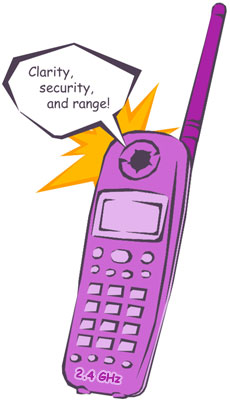
Cordless phones are by far one of our best selling products. Cordless phones offer portability and versatility that you just donít get with a corded phone. With new improvements in technology, the sound and security of cordless telephones now rival those of corded ones. And quite often you will find that cordless phones offer a great variety of advanced options. But with so many models to choose from, where does one start? Our cordless phones buyers guide will help you decide which phone is the best for you. So letís get started!

Whatís the frequency?
Thereís been a lot of talk recently regarding the newest technology to hit the cordless phone market: 2.4 GHz cordless phones. With a 2.4 GHz cordless youíll get much better clarity and better security and in some cases, better range. So what makes 2.4 GHz so much better than 900 MHz? Read on....Many people equate a higher cordless phone frequency with a better range. However, the way in which wireless technology really works is a bit more complicated than that. There are three important factors to consider when talking about the quality and strength of a cordless phoneís signal: interference, obstructions, and output wattage.
Youíre breaking up!
We live in a sea of wireless signals. Cellular phones, cordless phones, radios, pagers, and other wireless devices are constantly sending and receiving signals in the air around you. Even devices that donít talk to each other, like microwaves, refrigerators, TVs, and computers, emit low-band interference which can affect cordless phones in the 46-49 MHz bandwidth (found in a few of the least expensive cordless phones). Interference occurs when two or more devices use the same frequency at the same time. The FCC regulates which devices are allowed on each frequency.The first cordless phones utilized the 46-49 MHz bandwidth. As more and more people bought cordless phones, it became apparent that a new frequency would be needed. The FCC responded by opening the 900 MHz bandwidth. Previously reserved for military use, 900 MHz provided consumers with improved range and clarity. Cordless phones became even more popular and once again interference became an issue. If you have ever overheard a neighborís conversation, you know exactly what we are talking about here. The solution to this problem was to open up yet another frequency: 2400 MHz (AKA 2.4GHz).
The 2.4 GHz frequency band is recommended in most cases for the best possible clarity, security, and range. The only exception to this rule is the EnGenius, a long range cordless phones that far exceed most cordless telephones in range.
